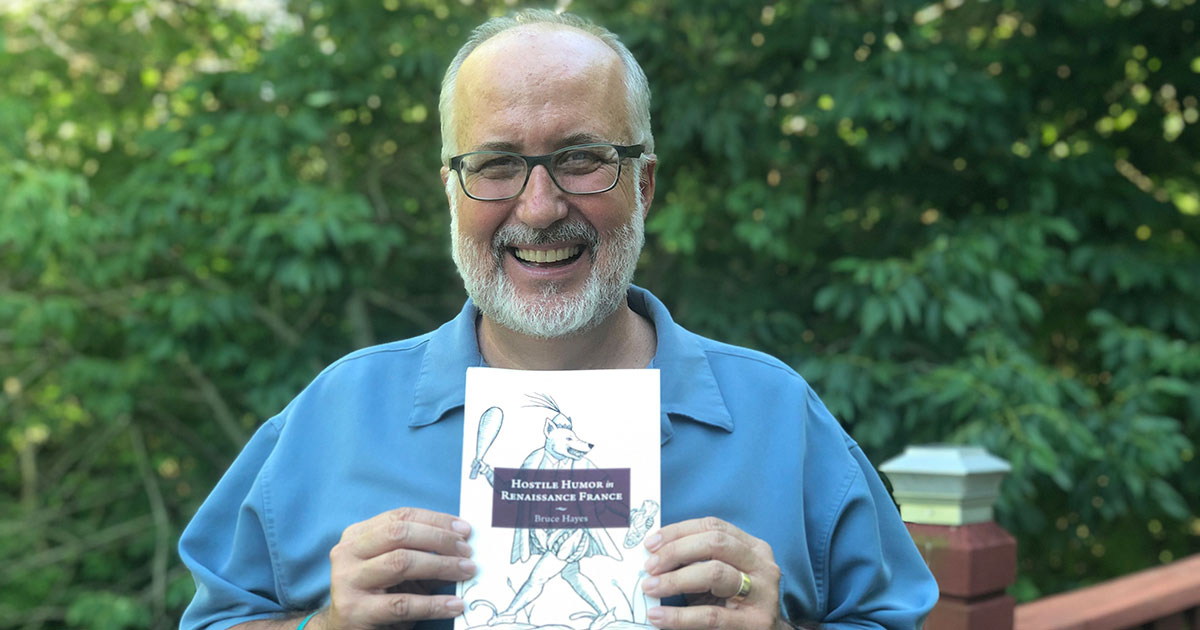Cruel jokes presaged civil war in Renaissance France

LAWRENCE – The legal concept of “fighting words” is well-established in American law, and Bruce Hayes understands better than most why that is so. The University of Kansas researcher's new book analyzes how hurtful words led to actual warfare in 16th century France.
In “Hostile Humor in Renaissance France,” (University of Delaware Press), Hayes analyzes the vicious gibes in posters, pamphlets and plays produced by the opposing sides — Protestant vs. Catholic — as they engaged in religio-political rhetorical combat.
Hayes is associate professor and chair of the Department of French, Francophone & Italian Studies.
His book begins by recounting the 1534 “Affair of the Placards,” when Protestants posted signs around France criticizing the Catholic Mass. It kicked off a 1500s version of a Twitter flame war, which, in turn, led to increased burning of heretics and ultimately to the biggest massacre of the century in Europe and nearly 40 years of civil war.
This early episode of the Protestant Reformation marked one of the first uses of the then newly invented printing press to engage in a propaganda campaign, Hayes said.
“I always say that it was the 16th-century equivalent of our social media,” Hayes said, “comparing what they could do with the printing press to what people could previously do. You could have these polemical battles and propaganda campaigns in a way that had not previously existed.”
Even if most 16th-century Frenchmen were illiterate, the placards and pamphlets were disseminated more broadly when literate people read them aloud in public, Hayes said. Theatrical performances were also staged.
“It's the first time when thousands of these pamphlets — a lot of them anonymous — appeared everywhere, to a degree that had no precedent,” he said.
Hayes writes that Protestant reformers – known in France as Huguenots – clearly started the rhetorical fight, and that ruling Catholics were at first slow to respond effectively. But once they engaged in the contest fully, they fought dirtily and effectively.
Hayes said that the broadsides from this period have not previously been well-studied for a couple of reasons.
“We have this particular idea of what we want the Renaissance to mean,” Hayes said. “We want it to be this period of enlightenment and progress. But the reality on the ground was quite a different matter.
“One of the reasons I think that these pamphlets have long since been ignored — other than the fact that they can be quite boring — is that they don't match up very well with our own modern sensibilities. You know, people are calling for genocide. We're not typically enthusiastic about that sort of thing. And yet that's exactly what in France the Catholic polemicists were doing, just like Protestant polemicists in England were doing against Catholics.”
There were plenty of serious theological issues for the two sides to argue about, but Hayes’s book concentrates on the sardonically humorous aspects of their rhetorical contest.
“My book is focused on a particular type of humor,” Hayes said. “I tried to explore the question, ‘At what point is humor no longer funny? At what point does the anger and the vitriol connected with the joke overpower the humor?’ And this is why I came up with this construct of the sardonic laugh.”
It’s a concept Hayes traces back to the Renaissance philosopher Erasmus.
“Often we think of humor as something that can defuse tension and make things more lighthearted,” Hayes said. “But this is a peculiar type of humor that does exactly the opposite. It condones violence. It incites violence because the butt of the joke is the other, the enemy. It's a form of dehumanization. It's the same thing that we find with racist jokes and sexist jokes. It's only funny if you're in on it, and you're not the object of it.”
Hayes said the Huguenots put “a lot of focus on the Pope, and they get really creative and aggressive in mocking and making fun of the clergy and particular Catholic practices like indulgences, saint worship and the monastic tradition. That was all fair game for them.”
For their part, Hayes said, “one of the main sources of this kind of sardonic humor on the Catholic side is making fun of the fact that Protestants let women and common people have access to Scripture.”
In the end, the Protestant challenge succeeded not in convincing most Frenchmen to leave Catholicism, but, rather, in fomenting France’s Wars of Religion that ran from 1562 to 1598.
“They just simply went too far with their jokes and with their caricatures and their satire, so that if you are a Catholic who didn't really believe or you were sitting on the fence, this stuff was too over the top,” Hayes said. “It didn't win a lot of converts. It just went too far.”
Hayes said he is already thinking about his next scholarly project, on a related topic.
“I'm going to explain, building on this, how it is that France develops this strong tradition of anti-religious satire,” he said. “And I think it's precisely because of these religious fanatics ... I would imagine that a lot of the population was not like that. But it was a Pandora's box, right? Once you could openly mock the Pope and all of these sacred traditions in Catholicism, you're not far away from being able to mock all religion, generally.”
Photo: Bruce Hayes’s book “Hostile Humor in Renaissance France” features a cover illustration by his daughter, Mado Hayes. Credit: Courtesy Bruce Hayes